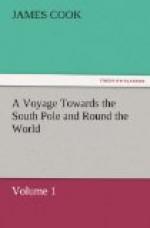The next day at noon, we were in latitude 36 deg. 10’ S., longitude 94 deg. 56’ W. Soon after, the wind veered to S.S.E., and enabled us to steer W.S.W., which I thought the most probable direction to find the land of which we were in search; and yet I had no hopes of succeeding, as we had a large hollow swell from the same point. We however continued this course till the 25th, when the wind having veered again round to the westward, I gave it up, and stood away to the north, in order to get into the latitude of Easter Island: our latitude, at this time, was 37 deg. 52’, longitude 101 deg. 10’ W.
I was now well assured that the discovery of Juan Fernandez, if any such was ever made, can be nothing but a small island; there being hardly room for a large land, as will fully appear by the tracks of Captain Wallis, Bougainville, of the Endeavour, and this of the Resolution. Whoever wants to see an account of the discovery in question, will meet with it in Mr Dalrymple’s collection of voyages to the south seas. This gentleman places it under the meridian of 90 deg., where I think it cannot be; for M. de Bougainville seems to have run down under that meridian; and we had now examined the latitude in which it is said to lie, from the meridian of 94 deg. to 101 deg.. It is not probable it can lie to the east of 90 deg.; because if it did, it must have been seen, at one time or other, by ships bound from the northern to the southern parts of America. Mr Pengre, in a little treatise concerning the transit of Venus, published in 1768, gives some account of land having been discovered by the Spaniards in 1714, in the latitude of 38 deg., and 550 leagues from the coast of Chili, which is in the longitude of 110 deg. or 111 deg. west, and within a degree or two of my track in the Endeavour; so that this can hardly be its situation. In short, the only probable situation it can have must be about the meridian of 106 deg. or 108 deg. west; and then it can only be a small isle, as I have already observed.
I was now taken ill of the bilious cholic, which was so violent as to confine me to my bed, so that the management of the ship was left to Mr Cooper the first officer, who conducted her very much to my satisfaction. It was several days before the most dangerous symptoms of my disorder were removed; during which time, Mr Patten the surgeon was to me, not only a skilful physician, but an affectionate nurse; and I should ill deserve the care he bestowed on me, if I did not make this public acknowledgment. When I began to recover, a favourite dog belonging to Mr Forster fell a sacrifice to my tender stomach. We had no other fresh meat on board, and I could eat of this flesh, as well as broth made of it, when I could taste nothing else. Thus I received nourishment and strength from food which would have made most people in Europe sick: So true it is, that necessity is governed by no law.
On the 28th, in the latitude of 33 deg. 7’ S., longitude 102 deg. 33’ W., we began to see flying-fish, egg-birds, and nodies, which are said not to go above sixty or eighty leagues from land; but of this we have no certainty. No one yet knows to what distance any of the oceanic birds go to sea; for my own part, I do not believe there is one in the whole tribe that can be relied on, in pointing out the vicinity of land.




